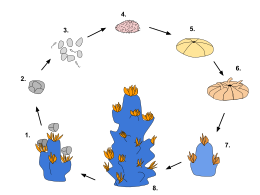
A group of the individual coral polyps that make up a stony coral colony. Life Cycle To reproduce corals produce eggs that develop into tiny swimming creatures called planulae.

Clusters break up at the surface followed by inter-colony gamete mixing and fertilization.
Life cycle of coral. Life Cycle of Corals Reproduction. During the first step of the coral reef life cycle clusters of column-shaped marine invertebrates called. Just a few hours after fertilization the eggs begin to divide and develop.
After an egg becomes a. A mature larva will. Lets recap the life and cell cycles of corals.
Coral polyps become sexually mature and their cells undergo meiosis producing gametes egg andor sperm. The gametes are fertilized producing a zygote. The zygote continuously creates new cells by the process of mitosis eventually forming a planula that settles and forms a coral polyp.
During the dying stage they live in their shells. Then there is the most important of them all coralwhen they are first born they look like milky clouds. The next stage in a corals life cycle is the youth stage.
During this time they divide constantly. Life Cycle of Coral Life Cycle of Coral. Coral Polyps release eggs which float around in the water for few days.
Adult and Child Coral. Just like a family each new coral will grow to be an adult coral. The older members will die.
The algae extract carbohydrates and fats from coral waste in exchange for energy the algae extract energy from the sun. This recycling process is a beautiful chemical conversation. Reef-building corals initiate photosynthesis as sunlight penetrates the waters of clear warm tropical shallows where coral thrive.
Life cycle of common coral trout Image produced for the project NESP TWQ Round 3 - Project 333 - Defining the values of the ecological systems that influence the GBR and lie outside the marine park and world heritage area boundaries. The majority of coral reef fishes have a complex life-cycle with two distinct phases. 1 a dispersive pelagic larval phase and 2 a sedentary demersal adult phase associated with the coral reef environment.
The larval phase ends at reef settlement. The data and models provided in this study detail the timelines for life cycle parameters at a range of biologically relevant temperatures information critical to aquarists looking to disrupt the coralivorous flatworms life cycle. As the coral aquaculture trade grows more effective management tools are required to control P.
Acroporae numbers in captive settings and this not only includes better targeted. Life Cycle To reproduce corals produce eggs that develop into tiny swimming creatures called planulae. Planulae eventually settle on a surface and develop into polyps.
The gallery illustrates how corals grow and reproduce the process from fertilised egg to larva to polyp before they form their coral structure. Coral Life Cycle in Tiltbrush by Sara Phinn Huntley 2019 About Press Copyright Contact us Creators Advertise Developers Terms Privacy Policy Safety How YouTube works Test new features 2020. Coral reefs are sometimes known as the rainforests of the sea Nearly a quarter of all the fish in the sea rely on healthy coral reefs.
Corals provide habitats for fish and other organisms in the ocean. The Northwest Hawaiian Island coral reefs are home to. When you look at a coral colony only the thin layer on its surface is live coral.
The mass beneath is the calcium carbonate skeleton that may be decades old. A group of the individual coral polyps that make up a stony coral colony. The damselfishes Pomacentridae have a bipartite life-cycle as do the majority of demersal coral reef fishes.
During their pelagic dispersion phase all larvae feed on planktonic prey. On the other hand juveniles and adults associated with the coral reef environment show a higher diversity of diets. The life cycle of the coral Acropora milleporaThe Acropora life cycle begins with a mass spawning event when all of the corals in a given area spawn simultaneously.
Buoyant egg-sperm bundles are released which break up on their way to the surface releasing the sperm to fertilize eggs from other colonies. Coral reefs are a precious resource in the ocean because of their beauty and biodiversity. Coral reefs also provide shelter for a wide variety of marine life humans with recreation a valuable resource of organisms for potential medicines create sands for beaches and serve as buffers for shorelines.
Life Cycle of Coralssvg. Sperm-egg clusters are released by polyps from colonies reef-wide. Gamete clusters float up to the surface of the ocean.
Clusters break up at the surface followed by inter-colony gamete mixing and fertilization. Embryos become ciliated planula larvae they are capable of settlement for up to 3-4.